A severe solar storm created a stunning display of light in the night sky over parts of the United States, Europe, Australia and New Zealand early Wednesday morning, spotted by those lucky enough to be awake in the wee hours.
Called aurora borealis in the Northern Hemisphere and aurora australis in the Southern Hemisphere, the lights were the product of large geomagnetic blasts from the sun that arrived Tuesday about 10 a.m. ET (1 a.m. Wednesday in Sydney).
Both the aurora borealis and the aurora australis were sparked by a particularly strong solar storm that sent charged particles toward the Earth, said CNN meteorologist Todd Borek.
“When these particles bombard the Earth’s magnetic field in the upper atmosphere, the collision often creates brilliant colors,” Borek said.
“Most of the time, auroras appear green — when these particles collide with oxygen in the atmosphere — but there were reports this past aurora australis also appeared to have a reddish tint, which suggested the collision with high-altitude oxygen was also seen on Earth.”
The stronger the storm, the farther south it can be seen, said Borek.
And this geomagnetic storm was rather powerful, reaching as a high as a G4 on a scale from 1 to 5 Tuesday night, according to NOAA’s Space Weather Prediction Center. The storm was expected to last 24 to 36 hours, and NOAA’s latest reports say it’s down to a G1.
Though the storm could affect GPS technology and power grids, NOAA said Tuesday that it had no reports of disruptions. The most visible impact as been this stunning light display.
If the auroras are seen again tonight, Borek said, they won’t be as pronounced and most likely won’t reach as far south as Tuesday night.
People in northern Michigan, northern Minnesota and Maine may be able to spot them, although he warned that clouds from Minnesota to Montana may impede visibility Wednesday night.
